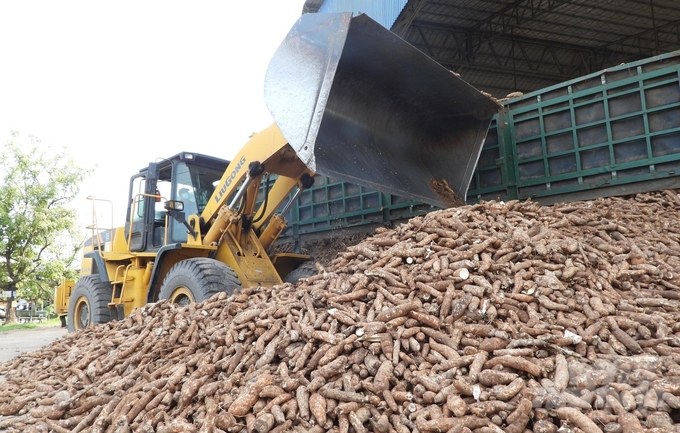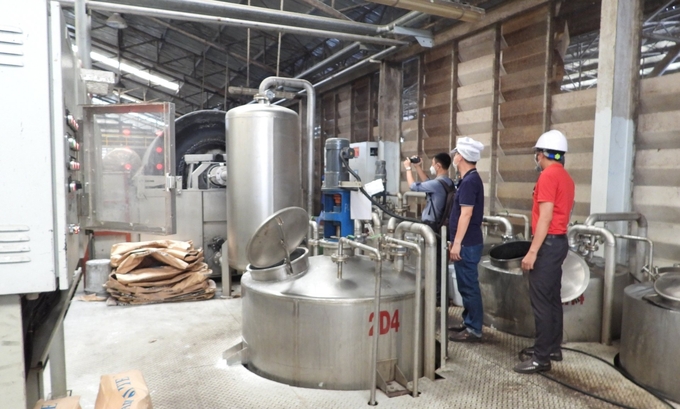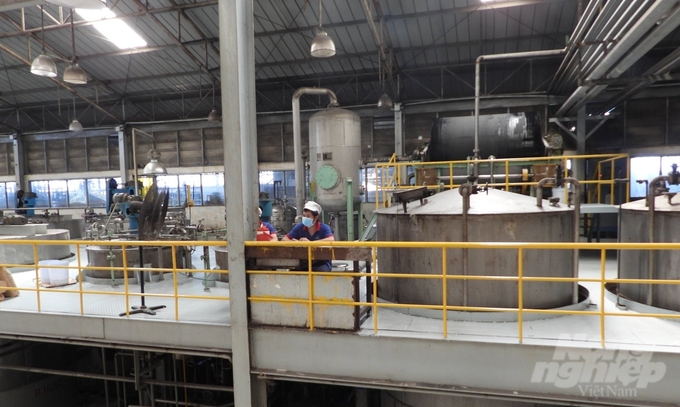December 7, 2025 | 19:36 GMT +7
December 7, 2025 | 19:36 GMT +7
Hotline: 0913.378.918
December 7, 2025 | 19:36 GMT +7
Hotline: 0913.378.918

Lack of input materials is a difficult problem for the cassava starch processing industry. Photo: Tran Trung.
According to the Vietnam Cassava Association, the country's cassava growing area is currently about 530,000 hectares, with a total output of over 10 million tons/year. The export turnover of cassava products increased from more than US$ 0.9 billion (in 2018) to nearly US$ 1.5 billion (in 2022). However, the raw material area currently only meets the needs of 30-40% of the factory's capacity. To achieve the set goal, first of all, it is necessary to solve the problem of imbalance between processing and raw materials. To do that requires the participation of management agencies, local authorities, and the cooperation between businesses and farmers.
Typically in Tay Ninh, the locality ranks second in area and tops in the number of cassava processing factories in the country. Due to the rapid development of processing factories, there has been considerable pressure on raw material areas.
According to a cassava processing enterprise in Tay Ninh, the demand for cassava starch in the world is increasing due to this product's wide range of uses. Today, cassava starch is not simply food but is also widely used in food, pharmaceuticals, cosmetics, and light industries such as confectionery and synthetic fibers, pellets, modified flour, spices... In particular, modified tapioca starch and malt are also the main raw materials for producing environmentally friendly biofuels, contributing to meeting consumer demand for fuel worldwide.

Many cassava starch factories operate slowly due to lack of raw materials. Photo: Tran Trung.
"With the main role of controlling inputs, we have recently focused on guiding farmers to farm sustainably and move towards organic production. The price of cassava starch from organic sources is several times higher, which will help increase the value per hectare of land while increasing export value and optimizing profits for farmers. In addition, we coordinate with scientists and international organizations to find good varieties to increase productivity and quality, improve the value of cassava in the field, and serve well as raw materials for factories", Mr. Xuan shared.
Regarding fundamental solutions, Mr. Nguyen Dinh Xuan said that Tay Ninh cassava industry is still limited as there is no link in investment in purchasing raw materials between processing factories and farmers, and no policy mechanism has been formed to attract long-term investment. For Tay Ninh's cassava to grow stably and truly sustainably, it is necessary to reorganize production towards building large production areas. This is the basis for linking with businesses to reduce intermediaries and create opportunities to upgrade the product value chain.
According to data from the General Department of Customs, in the first 10 months of 2023, cassava and cassava products exports reached over 2.39 million tons, worth US$ 1.02 billion, of which China is still the primary export market.

Cassava processing enterprises proactively innovate technology and improve quality to access and expand markets. Photo: Tran Trung.
In the first 10 months of 2023, although cassava exports decreased, cassava and cassava products to some markets still grew well in volume and value compared to the same period in 2022 such as Taiwan, Malaysia, Japan, EU...
According to Mr. Nghiem Minh Tien, Chairman of the Vietnam Cassava Association, for the cassava industry to develop stably, sustainably and with quality, Vietnam needs to restructure the domestic cassava industry and ensure the balance of raw materials in production. At the same time, build a linked cassava variety development center to create new seed sources to meet the seed needs of farmers promptly; ensure fairness of credit and tax policies; diversify export markets; Encourage and empower businesses to invest in environmental treatment and in-depth production and processing to enhance the value of starch.
For term III (2023 - 2028), the Vietnam Cassava Association targets the Chinese market as an immediate and long-term market, not replacing but not absoluteizing this market. "The Association views Northeast Asian countries and the EU as promising and potential markets while promoting the domestic market," Mr. Nghiem Minh Tien shared.
According to Mr. Nguyen Dinh Xuan: "In the coming time, in order for the cassava industry to grow further, factories need to be closely linked with farmers through ordering, investing, purchasing from farmers and having commitments to set standards. Standards like cassava farmers must follow VietGAP and organic standards... When farmers cultivate cassava professionally and meet standards, the selling price will be higher; The factory also ensures the legality of starch standards when exported to countries around the world."
Translated by Tuan Huy

(VAN) Despite numerous challenges, Vietnam's key seafood products are maintaining strong momentum, setting the stage for full-year exports to potentially reach USD 11 billion.

(VAN) The signing of a protocol between Viet Nam and China on the export of fresh jackfruit represents a significant milestone in agricultural trade cooperation between the two countries.

(VAN) On November 27, the Ninh Binh Department of Agriculture and Environment and the Institute for Green Growth Research organized a training course on greenhouse gas inventory for businesses.

(VAN) China’s cooking oil is suddenly flooding into India. It all comes down to a soybean surplus that Beijing doesn’t quite know what to do with.

(VAN) An Giang promotes supply-demand connections, standardizes quality and builds value chains, creating a foundation for sustainable bird’s nest development and aiming to expand exports.
/2025/11/24/5339-4-nongnghiep-075331.jpg)
(VAN) Recently, the conference on 'Sustainable Fisheries Linkage Chain - Tilapia for Export' took place in Tien Hai commune, Hung Yen province.
/2025/11/21/4309-2-153400_128.jpg)
(VAN) Green and low-emission rice is paving the way for Vietnamese rice to enter high-end markets, marking the beginning of a transformation journey toward greening and elevating the national rice brand.